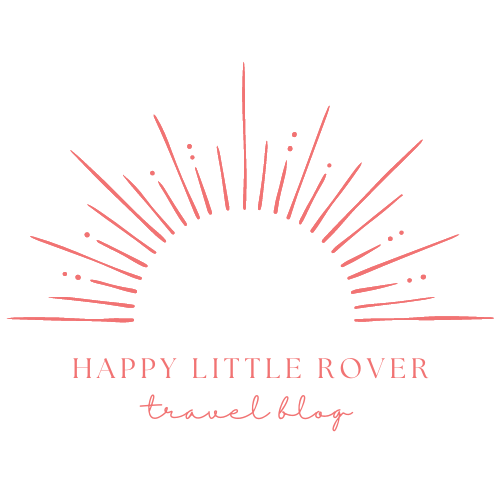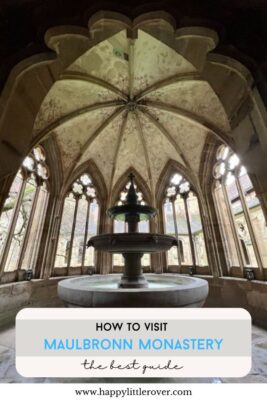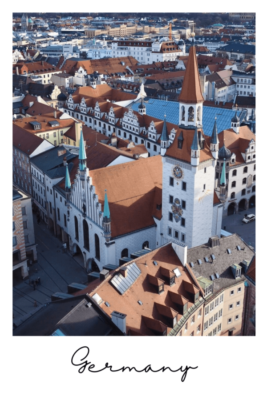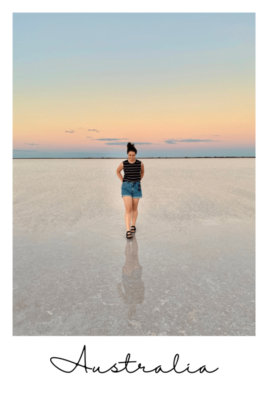How to visit the ancient Maulbronn Monastery: the best guide
Have you ever heard of the perfectly preserved Maulbronn Monastery, or as it’s known in German, Kloster Maulbronn?
The beginnings of this former Cistercian abbey and its surrounding buildings date back to 1147 and its even UNESCO listed for being an outstanding example of a late medieval monastic complex.
These days, the monks are long gone but visitors come from all over to marvel at the stunning Gothic chapel, beautiful fountain and charming timberwork on the surrounding buildings.
The monks even created a famous Swabian recipe that’s still popular to this day!
Come with me on a visit to this peaceful and serene Maulbronn Monastery!
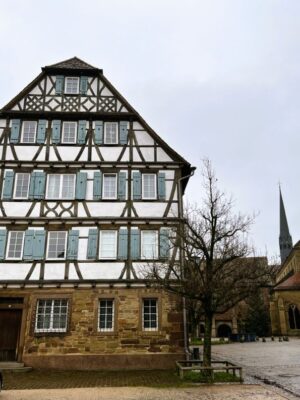
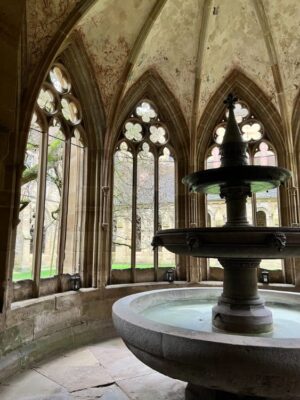
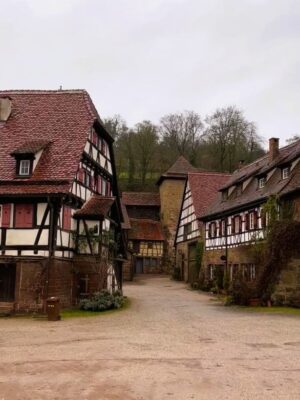
A brief history of Maulbronn Monastery
Originally, the monks who founded Kloster Maulbronn were based nearby at Eckenweiher, close to where Mühlacker stands these days.
The knight Walter von Lomersheim had donated his inherited land to the monks and joined the order, seeking a higher purpose.
But the Cistercians (the religious group that the monks belonged to) were mainly involved in agriculture and building and they needed better surrounding resources than what was available to them over at Eckenweiher.
So, according to legend, they loaded up a donkey with gold from their favourite knight and set it free, following it over hill and dale until it stopped to drink at a spring.
Which was the perfect spot to start building a new abbey, with adequate stone for quarrying and rich ground for farming.
Whatever the reason, land was gifted to them in their new chosen location – helps to know a bishop I guess – and they began building.
From 1147, they began building until finally completing most of the main buildings by 1201, the abbey was consecrated in 1178.
Without going too heavily into the fiddly details of monastic life, Cistercians mainly made their living by farming previously undeveloped land, with the help of lay brothers who went out and worked the land while the regular brothers worked on religious texts and study.
They wore white tunics made of wool and were not usually permitted to eat meat, though amusingly fish was okay as they were classified as “river vegetables”.
Even today, Maulbronn still has an elaborate network of ponds, lakes and channels that once functioned as a water supply, fish breeding grounds and drainage for the community.
The lay brothers were considered leaders in hydraulic engineering and the water system is still studied to this day for its ingenuity.
The brothers were so good at breeding fish that they even sold them as a source of revenue to the surrounding villages, they were also responsible for working the stone from the surrounding cliffs to create their staunch Gothic church and cloister.
They needed to be self-sufficient in order to survive and thrive, the abbey even wound up acquiring other convents and monasteries through the centuries thanks to their success.
The monastery was conquered in 1504 by Ulrich, Duke of Württemberg and he expelled the brothers, allowing peasants to live in the complex.
Convenient when the monks held valuable land and riches within the defensive walls.
It was eventually handed back to the monks in 1548, though the defeated Ulrich tried to oppose the reversal and his son, Christoph, eventually reformed the monastery into a Protestant school for academically gifted boys in 1556.
The monastery remained a boarding school, heavily focussed on academic pursuits and has produced quite a few famous writers and scholars.
Currently, the co-ed school still runs out of buildings at the rear of the complex and has around 100 students living on site, though unlike the Cistercian brothers, heated rooms are permitted.
Fortified over years of war during the 16th and 17th centuries, a hunting lodge was built for Duke Louis III and he directed his architect and builders to refurbish the monastery for the Protestant Seminary further.
Serious conservation efforts didn’t start until the 1840s but ultimately led to the entire complex being granted UNESCO status in 1993, as the best preserved and complete monastic settlement north of the Alps.
Looking for more? How about a city founded by monks, here’s my ultimate 3 day itinerary for Munich!
How to reach Maulbronn Monastery
Maulbronn lies roughly 18km to the northeast of Pforzheim, the nearest large city and 40km east of Karlsruhe. I’d recommend catching public transport from Pforzheim if you don’t have a car, the routes are much less direct from Karlsruhe and less frequent. I’ve outlined your options to reach Maulbronn below:
Via train: the Freizeitexpress Kloster Maulbronn train line (RB72) will depart Pforzheim and arrive in Maulbronn in around 18 minutes, running only on Sundays from late July to early September. While the station is very quaint and elegant, the bus below runs much more frequently.
Via bus: Take the 735 bus from Pforzheim, the trip will take around 35 minutes and the bus runs hourly throughout the week.
Via car: Driving from Pforzheim via Neulingen will take around 30 minutes, there is a reasonable sized car park just outside the monastery grounds. Driving from Karlsruhe, you’ll need about 45 minutes.
Admission cost and audioguide:
Admission per adult is 9€ and 4.50€ for a pensioner or child, family passes are 22.50€, excluding the audioguide hire.
With audioguide hire (available in English, French, German, Italian, Spanish, Japanese), admission is 12€ per adult, 6€ reduced and 30€ for a family pass.
Guided tours in German run 6 times a day in summer and 3 times a day in winter, you can double check the exact times on the official monastery website. Guided tours are also available by arrangement in English and French.
I would highly recommend getting the audioguide as it’s very informative and even has a sample of some of the hymns regularly sung by the monks.
Opening hours of Maulbronn Monastery
From 1st of March – 31st of October: 9:30am – 5:30pm (final entry at 4:45pm)
From 1st of November – 28th of February: 10:00am – 4:30pm (final entry at 3:45pm)
I’d say you’d need 1-2 hours to enjoy the ancient wonders of the monastery, depending on how much time you’d like to wander around all of the buildings and the museum inside the visitor centre.
Fun fact: Maulbronn is quite a popular wedding venue amongst the locals, we saw wedding guests getting photos while we visited!
Searching for another quaint village? Try this charming Bamberg walking tour
A witch’s tower and 14th century walls

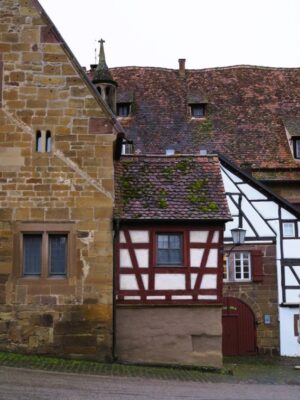
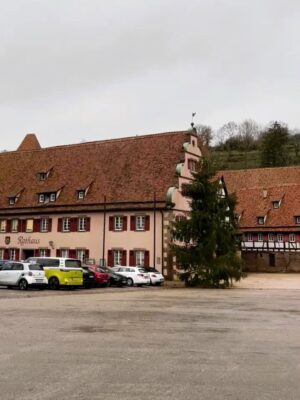
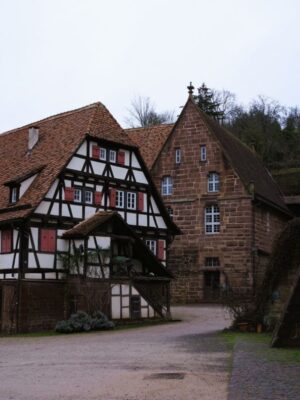
You’ll enter the complex through the original gateway which used to face a drawbridge over the moat surrounding the monastery – a wonderful medieval throwback.
The formidable walls and towers mostly date from the 14th century, you’ll see the Hexenturm or Witches Tower on your way along the walls from the carpark.
I loved the wonky roofline of the ancient buildings, testament to the high quality that the buildings were originally constructed to.
To your right, in the charming former gatehouse from the 1600s houses Kräuterhexe (“herb witch”) with a delightful selection of herbal teas, soaps and any other herbal requirements you might have.
Just past the main gate, a small pharmacy stands in a former inn (the Gasthaus) on your left, which was kept for housing visitors to the monastery.
The Frühmesserhaus next door houses a small museum which is currently closed and was probably used to feed staying guests as they needed to be kept separate from the brothers.
Around the corner, there’s an adorable little café serving up a limited menu, mostly featuring Swabian delicacies and yummy homemade cakes. Named Wagnerhaus Café im Klosterhof, feel free to pop by before or after the tour.
These buildings following on from the café used to house the lay brother’s crafting workshops, like a blacksmith’s forge and a wainwright.
A public house named Klosterschmiede formerly occupied these buildings but is now closed.
Continuing past the old pub, the pink building with baroque edging houses the Maulbronn Town Hall and government offices, you might spy Rathaus emblazoned on the side. It once housed the royal stables (Marstall).
Beyond this, the buildings are former stores (Haberkasten), the bakery (Pfisterei), grain mill (Klostermühle) and a dairy (Melkerstall), everything you’d need to keep a settlement running.
There’s also former kitchens (Speisemasterei) and a servant’s quarters (Gesindehaus), now converted to Restaurant Klosterkatz serving up delicious Italian classics, a Busarium office where records were kept (now a police station) and there’s even a beer garden out the back which opens up in the warmer months.
I was there in winter, so all the restaurants were closed for their Christmas break but it’s a charming spot to kick back with a beer and admire all the brothers’ hard work.
The ticket office and the rather large fruit box
On the opposite side of the courtyard, you’ll find a little carriage house and the tourist information centre/ticket office.
Pop in and grab your tickets and audio guide, the friendly staff will give you a quick rundown on how to use the little audio device.
I’d highly recommend grabbing the audioguide even if you speak German, there’s heaps of information in the audio snippets compared to what little there is to read on the signage scattered around the site.
They’ll also provide you with a map to help you find your way around all the complex’s relevant buildings – spoiler alert, the police station isn’t included on your tour.
The imposing, seven storied hall adjoining the tourist information centre was formerly a food storage facility, earning its name – Fruchtkasten or fruit box.
It also housed the monastery’s wine stores and dates from the 13th century, the current form of the hall dates from its renovation in 1580.
Seeing the size of this building, mostly devoted to food and wine storage, gives you a good impression of the thriving monastic community that used to call Maulbronn home.
There are plenty of events held here, like the Christmas markets and even concerts, which mean the former monastery grounds are still heavily involved in present day community life.

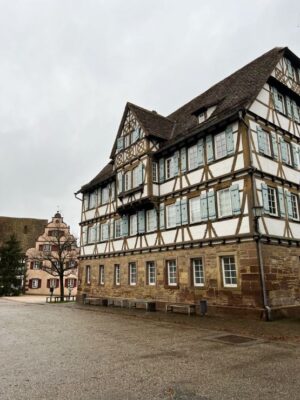
Paradise and the Monastery Church
Crossing over the wide-open space, we’re now headed to the main attraction, the famous cloister or church and its surrounds.
The church dates originally from the 12th century, being one of the first structures built on the site when it was granted to the monks.
Constructed originally in the Romanesque style, later renovations saw it become a curious blend of Romanesque foundations but soaring Gothic details above.
The church was consecrated in 1178 and was declared finished by 1201, just in time for the new century.
By this time, a new style of architecture was catching on, an unknown master builder created the Paradies or entry hall, which will be the first part that you step into – debate rages about whether the crescent moons chiseled into the stonework are his maker’s mark.
Named Paradise for the practice of painting the walls with images of the Garden of Eden (and Adam and Eve being expelled from the same), these days you can admire the elegant archwork and the wooden door formerly led to the lay brother’s side of the church.
Hard to believe that the doors are over 8 centuries old and are made of fir wood, one of the few features that survived from the original building.
Pass through the security gate after scanning your ticket and head on through to the serene monastery church.
Fun fact: Even though the doors in the Paradise are roughly 845 years old, they’re far from the oldest church doors in Germany.
The Hildesheim Cathedral has the cast metal Berward Doors which date to 1015, making them 1008 years old and historians aren’t sure if they’re even the oldest!

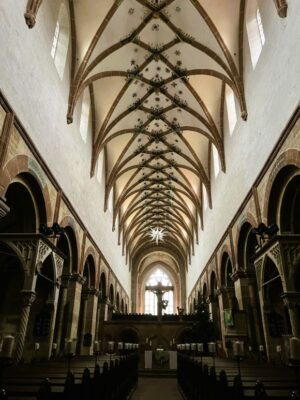
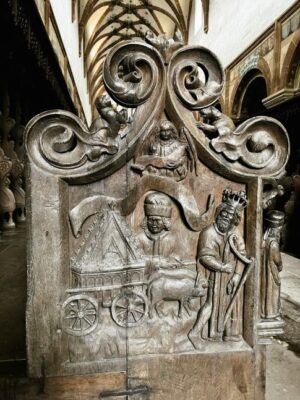
This impressive space displays the centuries of history, the walls and arcades are all Romanesque, while the exposed roof beam and high vaulted roof are Gothic, this new roof replaced the original flat roof in extensive renovations.
These took place in the latter half of the 15th century and were commissioned during a period of prosperity for the monastery.
Walk amongst the pews and look up to see the beautiful hand painted decorations on the vaults of the ceiling.
The large sculpture of the crucifixion fronting the pews may appear to be wooden but was masterfully carved from a single piece of stone.
Notice how there’s a large divider between the lay brothers’ side of the church (with the pews) and the monks’ side with the elaborately carved choir stalls.
The size difference between the two sections shows how many more lay brothers were needed to work the land and keep up the monastery compared to the monks, who mostly focussed on writing and prayer.
Don’t miss the fantastic detail in the carvings at the end of the choir stalls, I loved the intricacy of each carved little figure. You might also spot the footprints carved into the floor by many centuries of monks praying here.
The monks and lay brothers were essentially always kept separate with different dormitories, eating areas and even dressed differently, the lay brothers also didn’t need to have the tops of their heads shaved.
Unlike the monks were required to shave their heads up to 9 times a year.
A chilly thought considering that only one room in the entire monastery complex was heated and Cistercian monks weren’t permitted to wear any pants unless travelling outside the complex.
Directly to the lefthand side, a small stairwell led to the monk’s dormitory so they could go to their quarters without interacting with the lay brothers.
Let’s go take a look at the rest of the cloister.
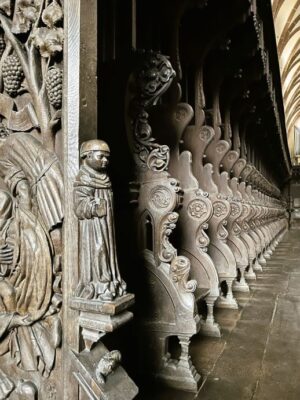
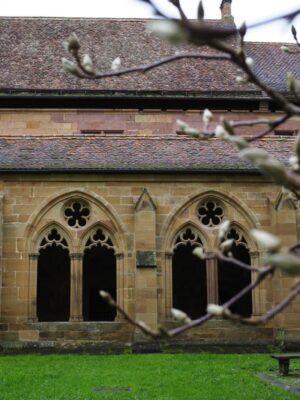
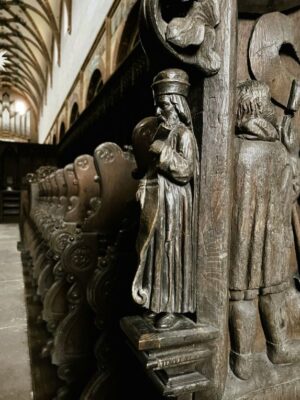
The Cloister and its legends
The cloister refers to the series of corridors and passageways that link all of the different rooms of Maulbronn Monastery.
You will pass through the Kapitelsaal or Chapter House where the monks sat and listened to readings from Scripture, see if you can spot the central column with multiple bird sculptures adorning the cornices, as well as more botanical illustrations on the roof.
A lavishly decorated passageway and reading hall led to an infirmary for the care of the old and sick, once called the Ephorat – now part of the boarding school that I mentioned above.
The Calefactory or warming room was the only room in the entire monastery that was permitted to be heated and the monks were allowed to warm themselves and their ink here for easier writing.
Stop into the elegant Herrenrefektorium or Monk’s Refectory where they enjoyed their meals (in silence apart from readings from the Bible) and admire the soaring arches.
The grooved column in the middle has a legend associated with it: wine was poured down the groove and the brothers were allowed to only dip their fingers into it for a taste, unproven though.
You may be able to spy the serving hatch that attached to the kitchen and on the far side of the former kitchen, we find the lay brothers’ dining hall – Laienrefektorium.
This squat and long hall served up heartier meals for the labourers of the monastery and these days, chamber music concerts are held here.
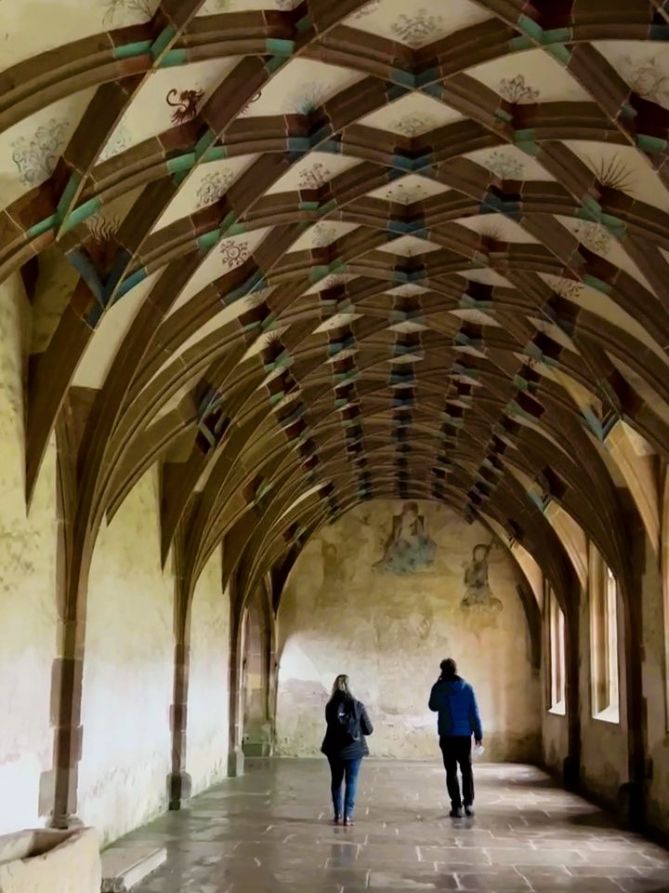

One of Swabia’s most beloved dishes actually originated right here in the monastery.
As the story goes, one of the monks happened across a bag of meat that had been dropped by a thief and brought it back to the monastery.
However, it was the season of Lent, therefore eating meat was prohibited for the Cistercian brothers.
Not wanting to waste any precious meat, Brother Jacob decided that he would wrap the minced meat in a form of dough similar to lasagna, thus hiding it from the heavens and allowing the monks to eat the Taschen or pockets during Lent.
These days, the savoury dumplings are known as Maultaschen – in reference to the monastery that they came from – you’ll be able to find them on many a menu in traditional restaurants around the region.
They’re traditionally served pan fried with pieces of bacon and onion, though there are other variations on the recipe depending on where you eat them.
Brother Jacob even lends his name to the beer garden out in the main courtyard as perhaps one of the monastery’s most famous residents.
The feature on every postcard from Maulbronn
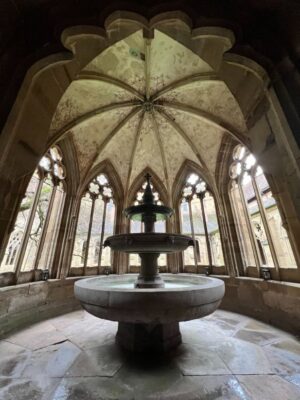
When you step out of the Herrenrefektorium, you’ll be immediately opposite the most recognisable symbol of Maulbronn Monastery – the triple tiered fountain.
Featured on many postcards and calendars, if you time it right, you may even see it when the magnolia tree outside is in bloom.
Only the lowest bowl is original, the only section remaining when conservators took over the monastery and the remaining sections have been reconstructed in a period appropriate style.
The monks used the fountain for washing before meals, shaving their heads and other ritual cleaning when needed.
Admire the original illustrations that the monks painted onto the roof, lovingly preserved through the ages.
Top tip: Don’t forget to look up and see if you can spot the preserved painting of the famous donkey that led the monks to Maulbronn, no sign of the bag of gold though!
From the central courtyard, you’ll be able to appreciate the delicate architecture of the Brunnenhaus (fountain house) with original stone from 1350 forming the walls, windows and roof.
The half-timbered section was added around 1611, such a quaint little addition but I couldn’t find what the tiny room would have been used for, likely part of the monk’s living quarters above.
The Eastern Courtyard and Lustschloss
Find your way back outside, as you leave, you can stop into the former Cellarium opposite the security gate to see some preserved stonework that has been discovered over the years.
Proceed around the back of the Monastery to see the gleaming white Lustschloss built by Duke Louis III in 1588, built after the dissolution of the monasteries.
All the buildings in this little area essentially belong to the school so you won’t be able to drop in and have a look.
Some of the famous minds to have attended the seminary include Herman Hesse, a Nobel Laureate poet and writer, and Johannes Kepler, an astronomer and mathematician from the 16th century who determined his laws of planetary motion.
There are also some ruins of a former elderly home which burnt down in 1899 and in the furtherest right corner, a tower that allegedly once housed the infamous Dr Faust (Faustturm).
And it’s even named after him, though nothing exists in the tower to prove that he stayed here or whether he did sell his soul to the devil for 24 years of magical abilities.
Accommodation in Maulbronn and beyond
I would advise just doing a day trip to Maulbronn and staying in either Pforzheim or Karlsruhe, as these are larger cities with more public transport links.
But if you’re travelling by car and you’d like to stay near the monastery, there are a few options within the village itself.
StuttgART36 is a family owned and run guesthouse just around the corner from the monastery complex while Zum Scheffelhof is set in a traditional hotel with a restaurant down below and rooms above, so maybe book with caution if it’s a party night.
Otherwise, as above, you’ll find plenty of options in the two bigger cities.
If it’s a hot day, you might like to stop by the swimming lake literally over the back fence of the monastery – Badesee Tiefer See, fed by the Salzach River and a popular spot for locals!
Entry is free and there’s a kiosk to buy snacks, toilets, changerooms and a large sunbaking area spread on the hill overlooking the lake.
You can also bring in your own food if you’d like.
Keen for another sunny destination? Try out these 10 things to do in Freiburg!

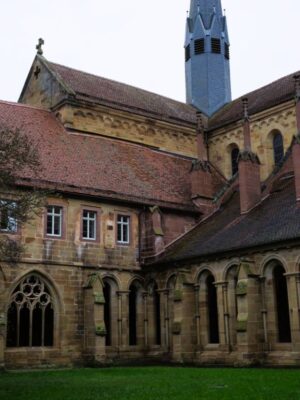
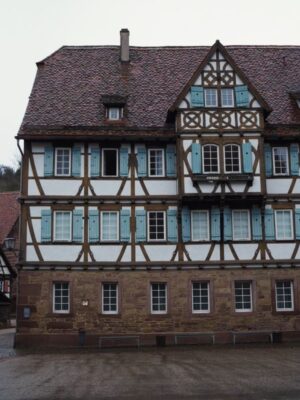
You’ve reached the end of this guide on how to visit the ancient Maulbronn Monastery!
We’ve strolled around charming stone halls and gingerbread houses, admired ancient woodcarvings and monk’s dining rooms inside the cloister and snapped our postcard shots of the fountain.
I hope you’ve enjoyed rambling around the Maulbronn Monastery with me and learnt a little bit about the ways of the Cistercians too, luckily for us they were good at building.
Time to go hunt down some hearty Maultaschen so you can try Brother Jacob’s delicacy for yourself, yum!
Don’t forget to let me know in the comments if you’d love to visit this serene spot and pin it for later.
